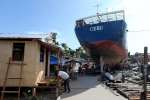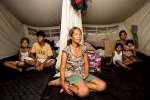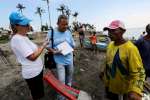- Text size
 |
|  |
|  |
| 
- Français
Typhoon Haiyan: Helping survivors to jump ship and land on their feet
News Stories, 24 December 2013
TACLOBAN, the Philippines, December 24 (UNHCR) – For 31 days, a rusting dredging ship tossed by Typhoon Haiyan 100 metres inland into a coastal shanty town was home for seven-month-pregnant Rosita Pica and her family.
Along with 38 other families, they shared cramped spaces inside the vessel that was also home to many dead bodies. The stench of decomposition mixed with the smell of crude oil and other odours was overpowering even more than a month later.
Living conditions were bad, but there was no other choice for the 34-year-old mother of five and 190 other survivors, mostly children. Their homes had been destroyed and debris was strewn all over. There was nowhere else to shelter them from the rains and looters roaming the city in the early days of the emergency.
"We had to endure it all. We had nowhere else to go," said Rosita, a survivor of Haiyan, the strongest cyclone to ever hit land, killing more than 6,000 people, uprooting trees and power poles and demolishing even concrete structures along its path.
Rosita and her family survived the storm by taking refuge in an evacuation site. Her hut was destroyed. When she and the other residents of an area called Barangay 75 saw the beached ship, they climbed the vessel that lay awkwardly among a sea of debris and took refuge there. They crammed its every nook and cranny, even the ledges in the engine room.
"It was hot during the night, mosquitoes feasted on us," Rosita said.
The people there shared one stove to cook food rations handed out by the government's Department of Social Welfare and Development. It rained most of the days and when it stopped, they would use two makeshift ladders to climb down from the vessel and sleep in the debris below. This was particularly dangerous for the children living on the ship.
Some local residents brought the plight of Rosita and the other residents to UNHCR's attention.
"When we found the community still living on the boat, we contacted UNDP [the UN Development Programme] that immediately mobilized its cash-for-work workers to clear some of the debris around the area," said UNHCR's Eilish Hurley, who has been deployed to Tacloban to respond to the crisis. "This allowed UNHCR and its partner agency CFSI [Community and Family Services International] to provide family tents for the boat residents so that they could escape the squalor and dangers that the ship posed to them."
Solar lanterns were also distributed along with blankets and kitchen sets to help communities temporarily set up a safer and more dignified living space while a permanent site was identified.
A day after receiving the tent, Rosita's husband – an assistant in an electrical shop – pitched it near the ship that was once their home. Rosita chatted animatedly with her neighbours, patted her tummy and remarked, "If this baby is a girl, I will name her Yolanda," referring to the local name for the typhoon.
Tacloban is gradually showing some signs of normalcy with roads being cleared, small shops re-opening slowly and electricity being restored in some parts of the city. But mounds of twisted corrugated iron roofs and steel, crushed concrete and wood still litter the landscape, including around the tents of Rosita and her neighbours. This is being cleared gradually by the government and UNDP.
Four million people still remain displaced after the storm and it will take many months and years before some of them are able to rebuild their homes and lives.
To date, UNHCR has assisted over 306,000 survivors of Typhoon Haiyan, distributing family tents, solar lanterns, plastic sheets, plastic rolls, blankets, kitchen sets and jerry cans.
The most appreciated items are the temporary shelter materials. UNHCR tents have been set up throughout the city, providing much-needed emergency shelter to people like Rosita. As she noted, these tents and solar lamps have given her and other families temporary respite from their suffering.
By Fernando del Mundo, in Tacloban, the Philippines













































